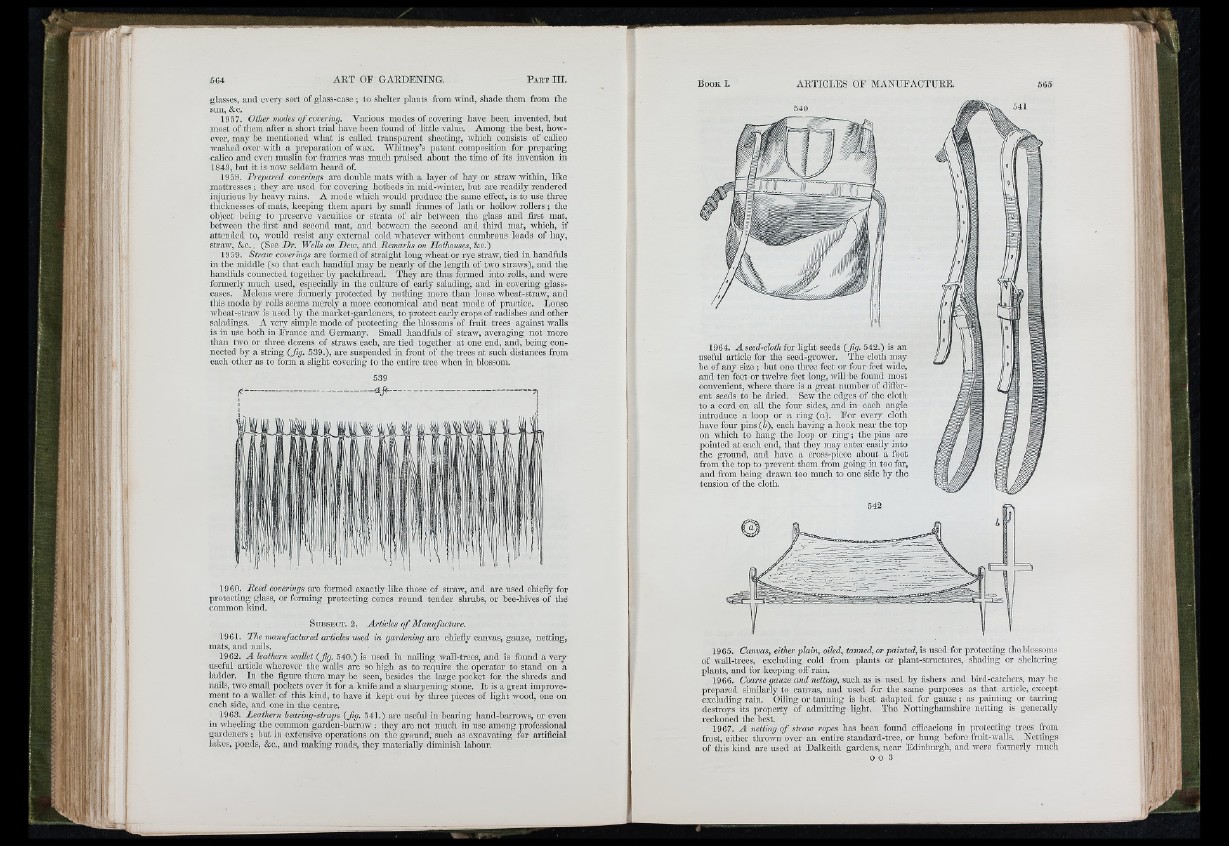
F ' i ' í í í
« r é ‘ r é ’
i ? V ?
Ì 4 4 L
glasses, and cvciy sort of glass-case ; to shelter plants from wind, shade them from the
sun, &c.
1957. Other mocks q f covering. Vai’ious modes of covering have been invented, but
most of them after a short trial have been found of little value. Among the best, however,
may bo mentioned what is called transpai’cnt sheeting, ivhich consists of calico
Avashcd over ivith a prepai-ation of wax. Whitney’s patent composition for preparing
calico and even mnslin for frames was much praised about the time of its invention in
1843, but it is now seldom heard of.
1958. Prepared coverings are double mats with a layer of hay or straw within, like
mattresses; they ai'C used for covering hotbeds in mid-winter, but are readily rendered
injurious by licaiy rains. A mode which would produce the same effect, is to use tlu’ce
thicknesses of mats, keeping them apart by small frames of lath or hollow rollers; the
object being to preserve vacuities or strata of air between the glass and fii-st mat,
between the first and second mat, and between the second and third mat, which, if
attended to, would resist any external cold whatever ivithout cumbrous loads of hay,
straw, &c. (Sec Dr. WeUs on Dew, and Remarks on Hothouses, &c.)
1959. Straw coverings ai’e formed of straight long wheat or rye straw, tied in handfuls
in the middle (so that each handful may be nearly of the length of two straws), and the
handfiils connected together by packthread. They are thus formed into rolls, and were
fomierly much used, especially in the culture of eai’ly salading, and in covering glass-
cases. Melons were formerly protected by nothing more than loose wheat-straw, and
this mode by roUs seems merely a more economical and neat mode of practice. Loose
wheat-straw is used by the market-gardeners, to protect eai’ly crops of radishes and other
saladings. A very simple mode of protecting the blossoms of fruit trees against walls
is in nse both in France and Germany. S m ^ handfuls of straw, averaging not more
than two or three dozens of straws each, ai-e tied together at one end, and, being connected
by a string (Jig. 539.), are suspended in front of the trees at such distances from
each other as to foi’m a slight covering to the entire tree when in blossom.
i ’i 'i
1960. Reed coverings ai'e formed exactly like those of straw, and are used chiefly for
protecting glass, or forming protecting cones round tender shnibs, or bee-hives of thé
common kind.
S t i b s e c t . 2 . Articks o f Manufacture.
1961. The manufactured articles used in gardening axQ cliiefly canvas, gauze, netting,
mats, and nails.
1962. A leathern wallet (fig. 540.) is used in nailing wall-trees, and is found a veiy
useful article wherever the walls are so high as to require the operator to stand on a
ladder. In the %uro there may be seen, besides the lai-ge pocket for the shi’eds and
nails, two small pockets over it for a knife and a sharpening stone. I t is a great improvement
to a wallet of this kind, to have it kept out by tlu'ce pieces of light wood, one on
each side, and one in the centre.
1963. Leathern bearing-straps (fig. 541.) are useful in bearing hand-barrows, or even
in wheeling the common garden-barrow ; they arc not much in use among professional
gardeners ; but in extensive operations on the ground, such as excavating for artificial
lakes, ponds, &c., and making roads, they materially dimmish labour.
Book I. ARTICLES OF MANUFACTURE.
540
1964. Aseed-clothioY light seeds (fig. 542.) is an
useful article for the seed-grower. The cloth may
be of any size; but one three feet or four feet wide,
and ten feet or twelve feet long, wiU be found most
convenient, where there is a great number of different
seeds to be dried. Sew the edges of the cloth
to a cord on all the four sides, and in each angle
introduce a loop or a ring (a). F o r every cloth
have four p in s (i), each having a hook near the top
on which to hang the loop or r in g ; the pins are
pointed at each end, that they may enter easily into
the ground, and have a cross-piece about a foot
from the top to prevent them from going iu too far,
and from being drawn too much to one side by the
tension of the cloth.
1965. Canvas, either plain, oiled, tanned, or painted, is used for protecting the blossoms
of wall-trees, excluding cold from plants or plant-structures, shading or sheltering
plants, and for keeping off rain.
1966. Coarse gauze and netting, such as is used by fishers and hird-catchcrs, may be
pared similai’ly to canvas, and used for the same pui-poses as that article, except
îluding rain. Oihng or tanning is best adapted for gauze ; as painting or tan-ing
destroys its property of admitting light. The Nottinghamshire netting is generally
reckoned the best.
1967. A netting o f straw ropes has been found efficacious in protecting trees from
frost, eithei- thi-own over an entire standard-trce, or hung before fruit-walls. Nettings
of this kind are used at Dalkeith gardens, neai- Edinbm-gh, and were formerly much
O o 3
prepa:
excliK
'I ' V
I ré
S rv
: ; it Í M